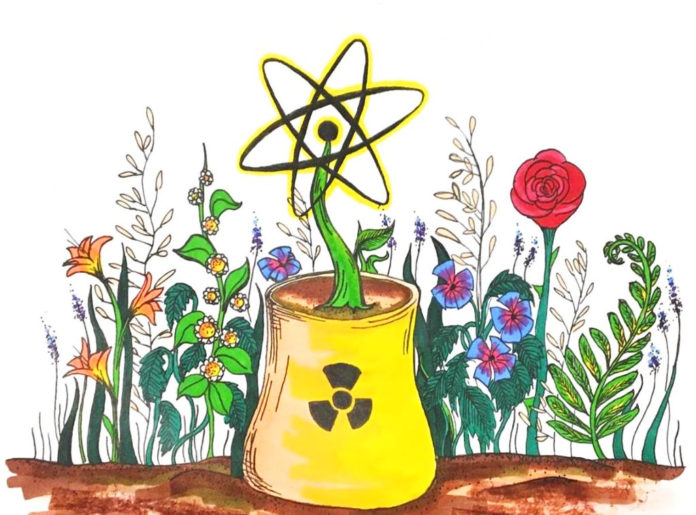After the World Climate Strike Sept. 20, California’s climate change activists demanded the state rely on carbon-free energy by 2050. California promises to go 100 percent carbon-free by 2045, with goals to utilize 50 percent renewable energy by 2025. Los Angeles’ climate march emphasized the need for effective climate change policies. However, one obvious carbon-free energy source was missing from protesters’ demands: nuclear energy.
The United States is the world’s largest producer of nuclear energy. Generating 19 percent of the country’s energy, it is the third-largest source following gas (35 percent) and coal (27 percent). Nuclear energy is reliable, operating efficiently 93 percent of the time. Other carbon-free energy sources rely on specific environmental conditions for operation — for example, solar energy has a 26 percent yearly capacity and wind energy has a 37 percent yearly capacity.
U.S. policymakers need to implement laws and dedicate funding toward nuclear energy. However, public opinion about nuclear energy has been skewed by reactor disasters and costly initial capital investments. As a result, we have overlooked what should be an obvious step toward carbon-free energy. The public debate over nuclear energy is largely uninformed about the realities of safety and waste management at nuclear power plant sites and fails to recognize the big picture.
California has the potential to spearhead nuclear energy conversations in the U.S. As of 2017, California’s single nuclear power plant in San Luis Obispo produced around 11.5 percent of the state’s energy supply, proportionately lower than the entire country’s energy production. In comparison, Arizona also has one nuclear reactor, producing 27.7 percent of the state’s energy. But the Diablo Canyon nuclear power plant in San Luis Obispo is due to be decommissioned by the state in 2025 until a comprehensive solution for waste collection is developed.
Waste is central to America’s nuclear energy debate. Waste repositories are the safest and most effective way to dispose of nuclear waste, but they are expensive. Until all plants can afford these repositories, they use dry storage facilities, which are safe, cost-effective and can last up to 50 years — enough time to install a proper repository. The 2018 Intergovernmental Panel on Climate Change (IPCC) report says we have less time than that to decrease our carbon emissions. We don’t have enough time to worry about 50 years into the future. Policymakers need to begin redirecting funding toward constructing waste repositories. This funding would propel nuclear energy to a frontrunning option for carbon-free energy.
While Democrats turn their attention toward avoiding a climate crisis, Republicans are reluctant to place the costs of renewable energy on taxpayers. The Green New Deal provides a pathway toward carbon-free energy and hope for climate change activists. The proposal is successful in targeting carbon-heavy economic sectors but fails to propose a reliable replacement for the 64 percent of America’s energy produced by fossil fuels, which is where nuclear energy comes in.
The Green New Deal initially planned to phase out America’s nuclear power plants to spearhead complete renewable energy. However, renewable energy sources alone cannot complete the shift to carbon-free energy because renewable sources such as wind and solar power are unreliable in terms of capacity for most regions.
Currently, 35 percent of America’s nuclear plants are at risk of shutting down because of operating costs, including California’s plants, because policymakers are unwilling to divert funds toward nuclear energy. If they close, this gap in 22 percent of America’s nuclear supply will be filled with coal or natural gas rather than clean renewables. Instead of phasing out nuclear energy, the Green New Deal should support constructing more nuclear power plants.
Voters are still concerned about the safety of nuclear power plants. Chernobyl is the biggest nuclear disaster to date, immediately killing 31 people and affecting thousands in the aftermath of radiation exposure. The 1979 Three Mile Island accident remains America’s single nuclear accident and resulted in no deaths. Since then, nuclear energy has only become safer. The Institute of Nuclear Power Operations (INPO) poses strict regulations on plants to ensure safety and prevent disasters, conducting regular evaluations of nuclear power plants and providing training for nuclear power experts. In comparison, 1,400 Americans die prematurely each year as a result of upper respiratory conditions caused by inhalation of particulate matter from coal emissions. There have been more coal-related deaths in the United States than nuclear energy-related deaths.
While nuclear energy is not a renewable source, policymakers and proponents of the Green New Deal haven’t even mentioned going 100-percent renewable in the near future. The most urgent climate crisis demand is rapid decarbonization, and nuclear energy is an effective way to meet that demand. Although integrating the construction of new nuclear power plants into the Green New Deal doesn’t have to be a long-term energy solution, we should embrace it as a step in the right direction. Climate change activism is effective in raising awareness about the climate crisis, but it is time to start getting specific about goals: nuclear energy is the future for carbon-free energy, and the transition needs to happen fast.
Claire Frohling is an undeclared sophomore. She can be reached at cfrohling@oxy.edu.
![]()




































